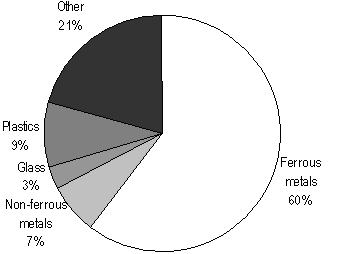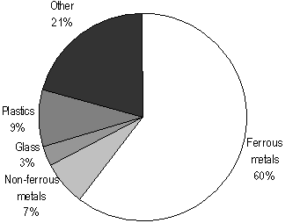How Does The Whiteware Industry In NZ Affect The Environment?
There is an increasing recognition of the total impact of industries on the environment. This is more than energy consumption during use by the consumer but end-to-end stewardship.
A report by MFE.govt.nz looked into the total effects of the whiteware industry. Below are some summary findings from that report.
The Raw Materials
Raw materials in home appliances
“Whiteware is made predominantly of steel, as can be seen in Figure 1, below. This steel component varies according to appliance, ranging from 90% for clothes driers and cookers to under 60% for dishwashers. The presence of metal is a major factor in the economic viability of whiteware recycling. Steel yields a relatively small price (less than NZ$200/tonne) while non-ferrous metals have significant monetary value. Copper, one of the common non-ferrous metals in whiteware, has a current market price in excess of NZ$5,000/tonne and is continuing to become more expensive due to a global shortage in supply. [See for example:Copper, Zinc Climb to Records in London Amid Supply Concern, fromwww.bloomberg.com10 April 2006.]”
The data above relate to the raw materials at the point of disposal. Given the increase in use of plastics in recent times, these data are somewhat skewed but do illustrate a point.
“..it is, therefore, likely the levels of plastic in end-of-life whiteware will change considerably in future years.”
However, some companies are making efforts to reduce their use of plastics where possible. For example,
“Electrolux has moved from wire-coated shelves in refrigerators to glass shelves. The primary reason, according to Electrolux, relates to consumer benefits in food safety. The use of glass may reduce the overall plastics content and introduces another recyclable material. Electrolux noted that anecdotal evidence suggests plastic shelves can become brittle and are prone to cracking, necessitating replacement.”
Given the typical life-span of different types of home appliance, it may be some considerable time before there are significant reductions in the end-of-life plastic volume.
To illustrate, the typical life span of different categories of domestic appliance are:
Appliance Average life span
Refrigerators 10-25 years
Freezers 20+ years
Dishwashers 10-20 years
Washing machines 5-15 years
Clothes dryers 15+ years
Electric cookers 15-20 years
Disposal Of Home Appliances
“Local authorities have responsibility for managing domestic waste and recycling in their geographical areas,” usually through “separation at recycling centres/refuse transfer stations/landfills.”
“Some councils divert resalable whiteware through stores at their recycling centres. A particular example is the SuperShed operated by Christchurch City Council. Others simply collect quantities of whitegoods at their collection sites and a scrap metal dealer will visit, crush the appliances with a mobile crusher, and pay the council a price according to the market rate for scrap. The collection of scrap metal, including whiteware, often brings in revenue for councils, although this depends on geographical location. After they have collected and crushed the whitegoods, scrap metal dealers will sell the material to Sims Pacific Metals Ltd for shredding.”
Recycling Raw Materials
Recycling is a problem in general for New Zealand given the small population. However some companies are making strides.
“There are only two shredders in New Zealand capable of processing scrap whiteware. Both of these shredders are owned by Sims Pacific Metals Ltd – the largest metal recycling business in New Zealand. Because whiteware uses a relatively light grade of steel, it is mixed with heavier grade items such as whole car bodies and processed through the shredders. Ferrous and non-ferrous metals are separated for recycling. The remaining material is known as “fluff” or “floc” and is made up of non-metal materials, such as plastics, wood, glass and rubber. It is estimated that 28-30% of the total material entering the shredders is floc, which is subsequently landfilled. Given current processing infrastructure and material values, this co-mingled and sometimes contaminated residual waste is not being recycled. While the constituent material types (eg glass, plastics, wood) might be technically recyclable, their co-mingled nature does not allow cost-effective recycling.”
Summary
On the one hand, there is an increasing number of products being bought as the number of households grows. On the other, manufacturers are starting to accept their responsibility in the end-to-end life cycle of domestic appliances. With that in mind, more are trying to reduce their use of plastics and look at more efficient use of raw materials. Concurrent with this, is the ever-increasing operating efficiency of the machines themselves reducing their individual impact on the environment.
To find a local Palmerston North appliance repairs company, click the link or got to this website https://nzappliancerepairs.co.nz.



No Comments
Be the first to start a conversation